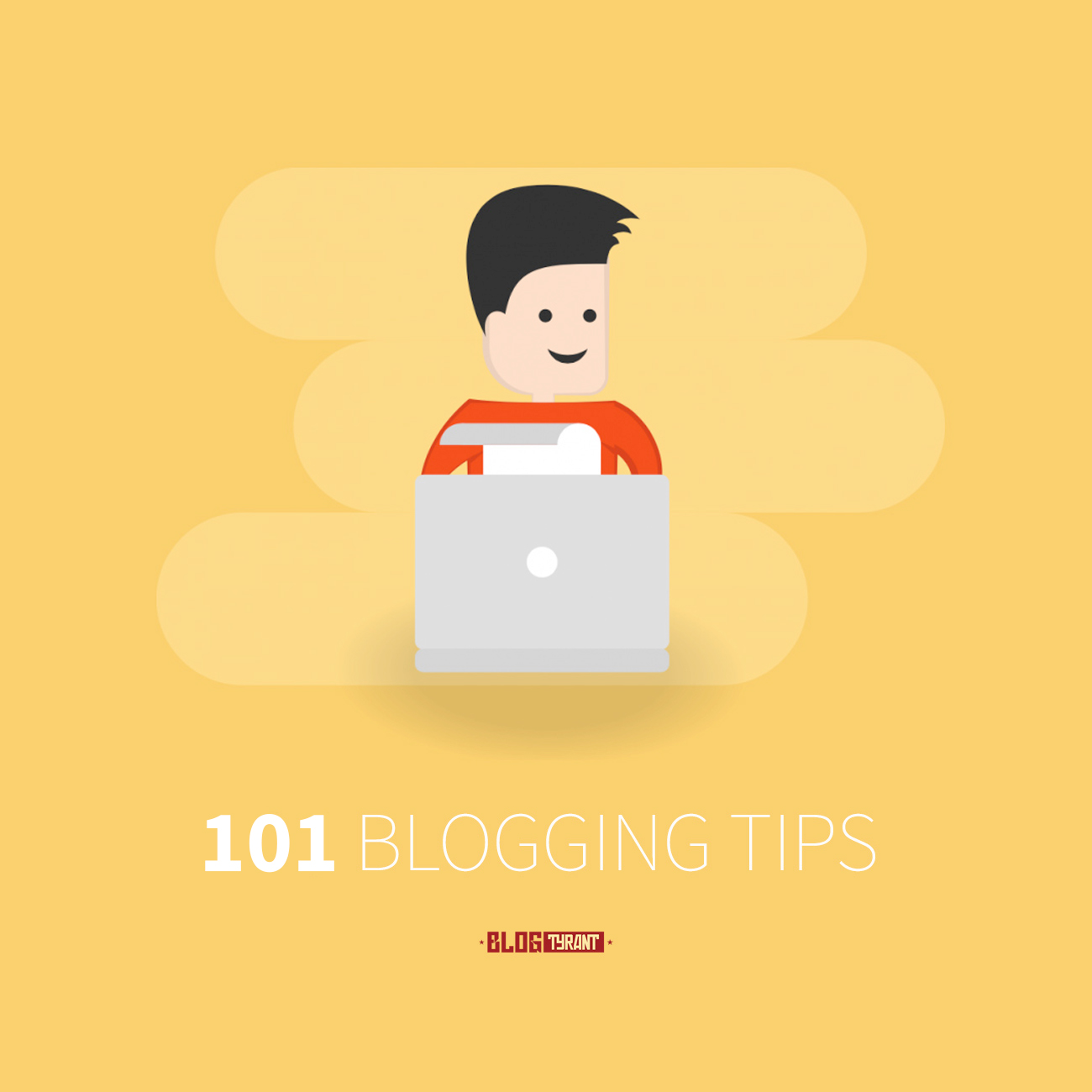
When you first start a blog it all seems simple. The deeper you go, however, the more complicated it becomes. Bloggers have to know about design, content creation, SEO, servers, security and so much more.
Sometimes it can all feel pretty overwhelming.
Today’s post is an enormous list of actionable tips that you can bookmark and refer back to when you’re having one of those days where you’re just not sure what to do next.
I’ve tried to break them up into rough categories but there will be some overlap so make sure you have a read of the sections that you think might not interest you.
Let’s go!
Content Creation

Producing helpful content is the backbone of any successful blog or website. Here are some tips to ensure you get the most out of everything that you produce.
- Generate your idea
You need a blogging strategy before you write anything. First think about reader feedback, a problem your industry is having or something your audience is interested in. Conduct research to see what else is being said on that topic. What’s on Google’s front page? How can you do it better? Will it help people? - Write at least 2,000 words
Long form is in, for the long run. Studies have shown that it performs better on Google and with social shares, and it allows you to cover a topic in enough detail that really helps people get an understanding. - Always include a photo
Don’t skimp on the image. There’s nothing worse than a stock image that adds no value to the article. It needs to fit in with your brand. Here’s a guide to finding photos for your blog that might come in handy. - Quiz your readers
You’ve probably seen BuzzFeed do it – I did one too. Quizzes are shareable and it’s great for back links. - Reach is important, not loyalty
Focus on getting in front of more people, instead of making your existing readers more loyal. Your content should be constructed for new readers. Ironically that leads to more loyalty. Read more about this idea here. - Create headlines that promote themselves
I’m not talking clickbait here, but something that tells the reader want to expect. A headline that entertains, educates and engages. Play around with ‘how to…’, ‘5 ways…’, and ‘the insider’s guide to…’ - Diversify your content
Experiment with different types of content formats. Try infographics, videos, webinars, worksheets, checklists, podcasts, and interviews. - Make your content actionable
Give your readers lessons and actions to take. Tell them how to best use the material you give them. Try and include a deliberate call to action somewhere in the post. - Publish at the best time
Where is the majority of your audience located? Hit publish at the peak time, for maximum exposure and results. Generally you want people to be at their desks, but not swamped by emails. - Use a caring and informal voice
It’s a good idea to try and write as if you’re talking to your best mate. You want to communicate but not in the way that a professor might talk to some first year students. Keep it easy. - Focus on beginners
The majority of the traffic to your website will be beginners – otherwise why would they be searching for solutions? Try to keep the perfect blog post focused on beginner issues in order to tap into more and more traffic. - Keep it evergreen
Evergreen content is content that stays relevant forever. Think “how to get into the Olympics” as opposed to “how to go to Rio in 2016”. You want your articles to rank on Google for the long term. - Include references
A good blog post is just like a good college essay in that it should contain quality references. Linking to other bloggers or research makes your article more credible, gives your readers new information to study, and also gets you in front of those websites. - Get help producing it
There is no need to do all the writing/image creation/video editing/etc. yourself. Get some help from experts on sites like Freelancer.com, Fiverr.com or 99Designs.com and become more prolific. - Own your content
I recommend starting a blog on your own host because then you fully own it. Medium and other free blogging platforms are great, but, like MySpace, there is no guarantee they will be around tomorrow. Don’t lose all your efforts. - Read, read, read
Find some blogs, books, and websites that you really love and spend some time reading them before you write. It will really get you into the right mindset and help to adjust your voice. I really love storytellers like George Saunders and other New Yorker contributors.
Advertising and Promotion

Creating content is not enough – we need to promote it to people. In fact, this might be one of the most important parts of blogging.
- Give away as much as possible
Free is okay. Don’t be afraid to give things away, especially when you’re starting out. You’ll really boost your reach by giving away valuable content, and it opens you up for sales opportunities in the future. - Create a mailing list & landing page
Start with your end goal, for example, to sell a book you’ve written. Now, work your way backwards by setting up a mailing list with an email series. Build their trust then drive them to a landing page that sells your book. A blog is a great way to promote your mailing list, and your mailing list can promote other things in turn. - Buy some ads
Your blog is a business. And just like everyone else, you need to promote it. Decide on a figure to spend each month and play around with it each month. Try Facebook ads or promote an affiliate product. - Create an eBook PDF
Find pre-loyal subscribers, add a revenue stream and increase your fans with an eBook. People love downloads. - Add dozens of links & resources
Linking to other blogs and influencers gets your blog on the map. These big names will hopefully share your stuff, link to you and it starts a new relationship – one which you can leverage on in the future. Once your article starts to get some traction you can tweet or email them to let them know they’re included. Don’t be pushy though! - Guest blog on websites
Get on blogs that are more popular than yours. It’s getting harder by the day, but the rewards are just as big as they ever were. It takes time to develop the relationships, but it’s worthwhile. - Cross-promote with other bloggers
Team up with other people in your niche so you can tap into their audience. Just make sure you genuinely love their work and that you can add something useful and meaningful. - Focus on the places that get the results
Check out Google Analytics and see which posts are performing well and which ones need work. Monitor keywords. See what’s trending. And, go! - Comment on other blogs
The right comment on a highly authoritative blog can help promote your blog. Identify the top blogs in your niche and get communicating. - Include social sharing in every post
Prompt your readers to share your content with their followers. Make sure you’ve got social sharing icons in your posts. Mashshare is a good one. But, yes, it’s okay to ask for a share now and then.
Goals and Planning
Blogging should be more than just writing a few posts and seeing what sticks. It can be a very good idea to spend a little bit more time on that strategy.
- Have a vague idea of the steps you need to take
Before you do anything it’s good to have some idea about what the steps are in the process. Here is a checklist for starting a blog that you can follow as a rough guide. - Choose the right niche
Your niche has to feel right for you. You really want to be able to add something different as well as having a good level of experience. Don’t worry too much about competition, but make sure you’re different. - Do your research
Cool, so you’ve got your niche. Now, who else is in it? Check out your competition. What are they doing well? Can you do it better? - Know your keywords
Your blog should focus on a specific set of keywords, and each post should enhance that. Know the short and long tail keywords you’re after and use tools like Majestic to look at your competition. - Start at the end
Even if you’ve just started out, you need an end goal. Write out how you envision making money from your blog and work your way backwards. - Have realistic benchmarks
Aim for steady, growing traffic levels, 500-1000 email subscribers, 3-4 guest posts and long-form content on a range of platforms. Don’t be too hard on yourself in your first year but make sure you have some numbers to hit. - Develop simple actions
Simplify your menu, sidebar and headers. Give people one action to take, such as subscribing to your email list. - Give it time
Don’t give up just when it’s starting to get good. Blogging results take time. Nothing worth having ever comes easily. Give it at least a year, of consistent hard work. Have short term and long term goals to keep you accountable. - Show your personality
Make your blog human and approachable. I kept my personality hidden for ages, but once I showed myself to my audience, everything changed, for the better. - Install this plugin
The WordPress editorial calendar plugin can be useful for bloggers who like to plan things ahead. It comes recommended by Melyssa Griffin who is absolutely killing it these days. - Ask someone for help
Before you set up any business or blog it’s a great idea to get a second (and third!) set of eyes on it. Ask for honest feedback, and feel free to reach out to experts you trust to see if they have any tips. They won’t always answer, but it can be very useful.
Branding

Your blog is just like any other business. The logo, colors, content, look and feel, etc. all need to communicate certain things to your readers. Let’s take a look.
- Know about branding
A brand is more than just your logo. David Ogilvy says it is “…the intangible sum of a product’s attributes: its name, packaging, and price, its history, its reputation, and the way it’s advertised.” - Choose wisely with your domain
Get an awesome domain. It’s an important promotional tool for your blog. It should be distinctive, short, and hopefully the .com version. - Set up an email address using your domain
It’s a good idea to have a personally branded email address. Once you buy a hosting package for your website you can set them up for free. - Get a logo developed
Think carefully about what you want to communicate, and how you want your site to look and feel, and then go on a freelancing site and have a logo developed. It’s not essential for a blog, but it can help differentiate you. Make sure your designer is legit, however, and isn’t copying it from somewhere else. - Become an authority by solving problems in your niche
You want to be the go-to blog for your niche. Do this by providing real content jam-packed with value. This doesn’t mean being an all-knowing expert, but someone who explores and tries to solve problems. - Communicate with people
Some bloggers find direct communication a good way to build trust, and other businesses use social networking sites to generate more sales. Experiment and see if it works for you. - Create a consistent set of graphics & visual cues
Take my little cartoons, for example. This audience now associates those graphics as part of Blog Tyrant – which can help with promotion and marketing. - Hone your unique voice
How do you want to sound to your reader? Your tone is important. The posts should sound like you. Let your personality out. - Consistency is key
Your fonts, colours, layouts, photos, header, post graphics, and post template should be consistent. Creating consistency develops trust. - Spend time on your About page
Tell your personal story but also talk about your readers. Let your readers connect with you. Use this page as an opportunity to get more subscribers too, it’s a really good place to convert. - Team up with the right people
You want to be known and mentioned by similar bloggers. Don’t look at them as competitors, but rather teammates. Try mentioning them in posts, helping them out, and then hopefully a useful relationship can form. - Don’t follow the crowd
If you do what everyone else does, you’ll never stand out. Try and see past the horizon, instead of getting caught up with the crowd. You need to try to be different in some way that people will remember.
Traffic and SEO

Organic traffic from Google is still one of the best forms of traffic. It’s competitive but the payoff is generally worth the wait.
- Figure out which traffic works
The best traffic source is different for everyone. Are you getting good conversions? If not, find more effective places to get visitors. - Google traffic is great, but don’t depend on it
Google traffic is still my main source of traffic but you want to make sure you have some diversity in case you get hit with an algorithm change. This is important. - Choose a topic, keywords and target market
Keywords still matter, after all this time. Research your keywords and go hard for the ones you want. Long tail keywords are wonderful. Use the Google Adwords suite of tools. - Install the Yoast WordPress SEO plugin
Yoast is a great SEO plugin. It’s the most popular SEO plugin and has many features that both help SEO and educate you as you use it. - Build back links naturally
Back links still matter in the world of SEO. You want authoritative sites to link to you, but you only want them to do it because the article you wrote is quality. Never pay for links. - Constantly tweak, according to your stats
Make sure your blog looks great for both Google and your readers. Be wary of Google updates and check their mobile testing tool. - Long content is still working best
Go long! I’m talking 2,000+ words. The longer the better with content. Give your audience posts that are packed with so much value they can’t not share. Don’t ramble, but find new ways to go deeper. - Update your titles and descriptions
Your titles and descriptions still matter. Add a fresh new spin to that awesome old post you wrote by re-writing your titles for Google. Remember, it’s like a little advert in Google’s listings. - Make your anchor text natural
In the old days you’d build links using anchor text that was the keyword or phrase that you were trying to rank for. For example, if you wanted to rank for the term “marketing blog” then you’d build lots of links that look like marketing blog. Google knows this trick now, so make anchor text natural and useful when linking back to your blog in guest posts, forums, etc. - Broadcast it on your social channels
So, you’ve got your channels now. Promote each post but do it in a way that encourages engagement and doesn’t just look like self promotion. Social shares are a big rankings factor for Google too, as far as I’m concerned. - Link out to other sites
A lot of bloggers are afraid of linking out to other websites for fear of diluting their page rank. Actually, the opposite is true. You should link to other blogs regularly as a way to provide further reading and get on their radar. - Check your page speed
The last thing you want is to frustrate your audience with slow page loads. Use Pingdom Tools to see what areas are slowing your site down and then try to make it faster. This is important for SEO. - Find different ways to be valuable
Google is trying to show its customers helpful content. If you can solve problems in different ways (other than just blog posts) then you’re more likely to attract shares, links and so on. This helps with your rankings. - Do an SEO audit
Some sites like Neil Patel’s have an SEO audit tool. This can be a good way to check if you’re making any huge errors and give you stuff to work on. - Use forums
Forums used to be big for getting traffic and then it became un-cool. But they still work. Join forums in your niche and engage in a meaningful way. You’ll find you profile grows and more people start to link to you and talk about your content. - Keep guest posting
Guest posting is not dead, it’s just different. Instead of obviously linking back to your articles you can use it as a way to get a new audience interested in your brand. Really go above and beyond and impress those who see your posts so that when they visit your site they become a fan and start sharing. - Stay up to date with SEO news
SEO changes regularly and it’s the kind of thing that you want to be ahead of. A lot of businesses got burned, for example, with the Panda update, and you need to make sure this doesn’t happen to you. - Consider paying for help
I don’t recommend paying for SEO services that build links, but it can be a good idea to get advice and training from someone like ViperChill when it comes up. The strategies that those guys share can be hugely valuable. Even if you only learn one thing, it can make an enormous difference. - Build mini-sites
Glen recently talked about the power of mini-sites for driving back links. It’s a bit outdated now but still works – you make a small site on a sub-topic related to your main blog. Blog Tyrant will have another site launching soon that will be an example of this. - Don’t forget print media
I’ve seen some bloggers get covered in old-school newspapers or local magazines and get a huge hit of traffic and reader loyalty. It’s a great trust factor. Reach out to journalists as a lot of them are desperate for content. - Find your best social media battleground
Some niches do extraordinarily well on Snapchat, while others completely fail. Instagram is big for food, travel and fitness bloggers, but might not be so good for technical stuff. Figure out what social platform works for you and focus on that and less on others.
Design and conversions

A lot of bloggers and online business people “poo poo” design as not being important. The truth, however, is that even some very small design issues can really wreck your conversions. Here’s some important tips.
- Go narrow with your content width
People don’t like to read long lines of text as it seems it is more difficult and our brain likes to jump around a lot. Be careful with how wide your content is laid out. - Make sure your theme is mobile responsive
A large portion of readers now access blogs on mobile devices. Furthermore, Google is also penalizing websites that don’t have a responsive design as it doesn’t provide a great experience. - Split test design elements
A red button might look great but does it convert as well as a green one? Use a testing tool like VWO in order to test different areas of your page and see what helps conversions. - Think about your colors
Some colors can have a negative impact on your readers. For example, the Australian Government found that certain greens really put people off. Make sure your colors are contributing in a good way. - Make the area above the fold valuable
Above the fold is the area of your site that readers see before they have to scroll. This should be an area that is eye-catching and engaging. If it’s not, you often find that your bounce rate increases. - Make your whole website a funnel
Think about your blog as being a funnel that directs readers towards one or two specific outcomes. We should use design, links and content to create specific outcomes. - Develop specific landing pages for your mailing list
Your mailing list deserves more attention than a small box in your sidebar. Develop a nice landing page that promotes your mailing list’s offer and benefits. Mine converts at over 60%. - Use a scroll-triggered box plugin
Plugins like this one allow you to make a little box that slides out when a reader scrolls a certain distance. It’s less obtrusive than a popup and can help increase traffic to certain areas, promotions, or your mailing list. - Read websites like Smashing Magazine
Site like Smashing Magazine are a great way to learn about trends and design tweaks that can help your blogging efforts. - De-clutter everything
Part of the reason I removed my sidebar was because I wanted to keep the focus on my content and mailing list offer. It’s been working well. Remove all the extra stuff and decide what your blog’s main goal is. - Use a larger font
Large fonts have many benefits that you might not realize. Google Fonts is a good place to get them.
Security and Performance
When you own a physical business you need to know about rent, stock, alarm systems, etc. The same is true for a blog. Here are some tips to keep your website performing and secure from threats.
- Use a complicated username and password
Don’t use “admin” as you username and make sure you have a complicated password that is individual to each site. Don’t repeat them anywhere. Consider using LastPass to help you remember. - Don’t use public WiFi
Public WiFi in airports and cafes is a good way to have your computer compromized because connections aren’t always secure. Avoid it and just tether your phone. - Use a VPN
If you need to use that public WiFi in hotels or cafes for traveling make sure you have a VPN on your computer. This helps to encrypt your data when you log in to websites and so on. - Keep your computers, software, plugins and browsers up to date
Almost every time you see an update for your phone or WordPress installation it contains a security patch. It’s very important that you keep things up to date all the time because threats are updated as well. - Don’t click links in emails you don’t know
If you get an email from your bank or the tax office telling you to click this link because you’ve done something wrong, it’s most likely a scam. Don’t click links in emails unless you’re 100% you know who it is from. If in doubt, close the email and type the website into Google. - Consider two-factor authentication
Most important services like your bank, email, server, etc. will allow you to setup two-factor authentication as an extra security step. This is a good thing to do. - Use a security plugin for WordPress
Security plugins like Bulletproof Security can go a long way to helping you keep your site secure. They take a bit of learning but it’s worth it. - Ask your host for security advice
Open a support ticket with your support staff and ask them to help you harden your website. They’ll make recommendations about changing permissions and blocking IPs. It’s very valuable. - Install a caching plugin
Caching plugins like W3 Total Cache can be a little bit tricky to learn but will help speed up your site. You can also do this from your server end. - Reduce image sizes
A lot of blog slow down seems to be caused by huge images. Reduce their size before saving them or use a compression service that strips away non-essential information embedded with the image. - Go easy on the plugins
I know bloggers who have 40-60 plugins installed on their WordPress site. Not only is this a security risk (they all have to be maintained), it also slows down load time. Try to reduce the amount you need, and have a developer code any features you really need into the site. - Use Pingdom Tools
This cool online tool can test your website to see how fast it is loading and what elements are causing the slowdown. This can provide great insights into things that are inefficient. - Make sure your server is suitable
Shared servers are great because they save you money as well as using less energy to power, but after a while you can outgrow them. Check the throttling section of your cPanel and see whether it might be time for your to upgrade to a VPS or similar. If you’re hitting a few thousand visitors a day it might be time. - Consider a CDN
A Content Delivery Network is a bunch of servers located around the world that help to deliver your content more efficiently. It can be a really good way to shave of load time if your website needs a boost – especially for delivering heavy content like image and videos. - Remove advertising networks
Often when you visit a website and it lags and lags it’s because of some horrible ads network that is trying to display dozens of pop ups and other rubbish. There are better ways to make money from a blog and I recommend trying to move away from them.
Lifestyle and Health
Working on a blog or an Internet business can be a big adjustment if it’s new to you. It can also take a big toll on your physical and mental well being. Here are a few tips that have helped me.
- Don’t sit still
Sitting still for long periods of time has been shown to be as harmful as smoking. The bad news? Exercising at the end of the day doesn’t seem to undo the damage. We need to get up every 20 minutes or so and move around. - Get outside often
The vitamin D production associated with regular exposure to sunshine is important for immune health and mental health. We tend to stay indoors much more than most people. Try to get outside every day for a run or even a walk in the park. - Watch out for screen apnoea
Ever heard your overweight father sleeping and “missing” a breath every now and then? That’s possibly a sign of sleep apnoea. Turns out people on computers do it too and it is extremely bad for your brain. - Don’t bend your head forward
Looking at a smartphone or laptop screen at an angle as small as 15 degrees can put up to 30lbs of pressure on your spine. This damage is very hard to undo. - Be careful of your stress levels
Stress can creep up on you, especially if you work long hours alone. Humans need good relationships to be happy and things like sport, meditation, and regular socializing can really help combat stress before it becomes a long term issue.
So, what’s next?
I really hope there was at least a few interesting tips for you in there!
If I’ve missed something that has been really affecting your blog or online business lately please leave me a comment below and I might be able to address it in a future article.
Lastly, if you enjoyed this post please consider giving it a share using the buttons below – it’d really help me out.
101 Blogging Tips to Keep You Moving Forward originally posted at Blog Tyrant

No comments:
Post a Comment